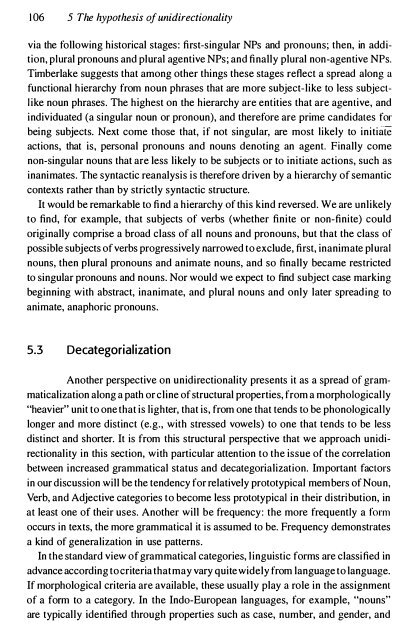Gram - SEAS
Gram - SEAS
Gram - SEAS
You also want an ePaper? Increase the reach of your titles
YUMPU automatically turns print PDFs into web optimized ePapers that Google loves.
106 5 The hypothesis of unidirectionality<br />
via the following historical stages: first-singular NPs and pronouns; then, in addition,<br />
plural pronouns and plural agentive NPs; and finally plural non-agentive NPs.<br />
Timberlake suggests that among other things these stages reflect a spread along a<br />
functional hierarchy from noun phrases that are more subject-like to less subjectlike<br />
noun phrases. The highest on the hierarchy are entities that are agentive, and<br />
individuated (a singular noun or pronoun), and therefore are prime candidates for<br />
being subjects. Next come those that, if not singular, are most likely to initia - ie<br />
actions, that is, personal pronouns and nouns denoting an agent. Finally come<br />
non-singular nouns that are less likely to be subjects or to initiate actions, such as<br />
inanimates. The syntactic reanalysis is therefore driven by a hierarchy of semantic<br />
contexts rather than by strictly syntactic structure.<br />
It would be remarkable to find a hierarchy of this kind reversed. We are unlikely<br />
to find, for example, that subjects of verbs (whether finite or non-finite) could<br />
originally comprise a broad class of all nouns and pronouns, but that the class of<br />
possible subjects of verbs progressively narrowed to exclude, first, inanimate plural<br />
nouns, then plural pronouns and animate nouns, and so finally became restricted<br />
to singular pronouns and nouns. Nor would we expect to find subject case marking<br />
beginning with abstract, inanimate, and plural nouns and only later spreading to<br />
animate, anaphoric pronouns.<br />
5.3 Decategorialization<br />
Another perspective on unidirectionality presents it as a spread of grammaticalization<br />
along a path or cline of structural properties, from a morphologically<br />
"heavier" unit to one that is lighter, that is, from one that tends to be phonologically<br />
longer and more distinct (e.g., with stressed vowels) to one that tends to be less<br />
distinct and shorter. It is from this structural perspective that we approach unidirectionality<br />
in this section, with particular attention to the issue of the correlation<br />
between increased grammatical status and decategorialization. Important factors<br />
in our discussion will be the tendency for relatively prototypical members of Noun,<br />
Verb, and Adjective categories to become less prototypical in their distribution, in<br />
at least one of their uses. Another will be frequency: the more frequently a form<br />
occurs in texts, the more grammatical it is assumed to be. Frequency demonstrates<br />
a kind of generalization in use patterns.<br />
In the standard view of grammatical categories, linguistic forms are classified in<br />
advance according to criteria that may vary quite widely from language to language.<br />
If morphological criteria are available, these usually play a role in the assignment<br />
of a form to a category. In the Indo-European languages, for example, "nouns"<br />
are typically identified through properties such as case, number, and gender, and
















